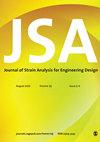确定二维非周期晶格结构线弹性特性的计算方法
IF 1.4
4区 工程技术
Q3 ENGINEERING, MECHANICAL
Journal of Strain Analysis for Engineering Design
Pub Date : 2023-01-26
DOI:10.1177/03093247221150666
引用次数: 3
摘要
本文提出了一种确定非周期点阵结构线弹性性质的框架。实现了一种基于元素的材料分配方法,便于在结构化网格上生成和分析任意图案。一种适应的数值均匀化策略的特点是在域边界附近包含均匀化区域,验证了周期或非周期晶格结构的任意有限斑块的周期边界条件的实现。为了证明该方法,对基于Penrose (P3)模式的非周期晶格模式的线弹性特性进行了评估。这样的结构没有平动对称而显示有序,因此缺乏重复的单位细胞。研究了非周期晶格结构的各向同性性能,并与众所周知的方形周期晶格结构进行了比较。该框架为其他不基于重复单元细胞的新型细胞结构的调查和分析打开了大门。增材制造促进了这种晶格结构的物理实现,使它们成为航空航天和生物工程行业中传统周期性结构的可行替代品。本文章由计算机程序翻译,如有差异,请以英文原文为准。
A computational method for determining the linear elastic properties of 2D aperiodic lattice structures
This paper develops a framework for determining the linear elastic properties of non-periodic lattice structures. An element-based material assignment methodology is implemented that facilitates the generation and analyses of arbitrary patterns on a structured mesh. An adapted numerical homogenization strategy features the inclusion of a homogenized region in the neighbourhood of the domain boundary that validates the implementation of periodic boundary conditions for an arbitrary finite patch of a periodic or non-periodic lattice structure. To demonstrate the method, the linear elastic properties of an aperiodic lattice pattern based on the Penrose (P3) pattern is evaluated. Such a structure exhibits order without translational symmetry and consequently lacks a repeating unit cell. The isotropic performance of the aperiodic lattice structure is investigated and compared to that of the well-known square periodic lattice. The framework opens the door to the investigation and analyses of other novel cellular structures which are not based on a repeating unit cell. Additive manufacturing facilitates the physical realization of such lattice structures, presenting them as viable alternatives to conventional periodic structures in the aerospace and bio-engineering industries.
求助全文
通过发布文献求助,成功后即可免费获取论文全文。
去求助
来源期刊

Journal of Strain Analysis for Engineering Design
工程技术-材料科学:表征与测试
CiteScore
3.50
自引率
6.20%
发文量
25
审稿时长
>12 weeks
期刊介绍:
The Journal of Strain Analysis for Engineering Design provides a forum for work relating to the measurement and analysis of strain that is appropriate to engineering design and practice.
"Since launching in 1965, The Journal of Strain Analysis has been a collegiate effort, dedicated to providing exemplary service to our authors. We welcome contributions related to analytical, experimental, and numerical techniques for the analysis and/or measurement of stress and/or strain, or studies of relevant material properties and failure modes. Our international Editorial Board contains experts in all of these fields and is keen to encourage papers on novel techniques and innovative applications." Professor Eann Patterson - University of Liverpool, UK
This journal is a member of the Committee on Publication Ethics (COPE).
 求助内容:
求助内容: 应助结果提醒方式:
应助结果提醒方式:


